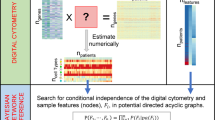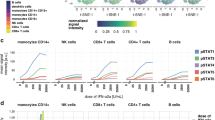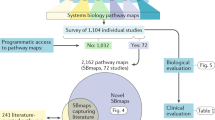Abstract
The fundamental components of many signalling pathways are common to all cells1,2,3. However, stimulating or perturbing the intracellular network often causes distinct phenotypes that are specific to a given cell type4,5. This ‘cell specificity’ presents a challenge in understanding how intracellular networks regulate cell behaviour and an obstacle to developing drugs that treat signalling dysfunctions6,7. Here we apply a systems-modelling approach8 to investigate how cell-specific signalling events are integrated through effector proteins to cause cell-specific outcomes. We focus on the synergy between tumour necrosis factor and an adenoviral vector as a therapeutically relevant stimulus that induces cell-specific responses9,10,11. By constructing models that estimate how kinase-signalling events are processed into phenotypes through effector substrates, we find that accurate predictions of cell specificity are possible when different cell types share a common ‘effector-processing’ mechanism. Partial-least-squares regression models based on common effector processing accurately predict cell-specific apoptosis, chemokine release, gene induction, and drug sensitivity across divergent epithelial cell lines. We conclude that cell specificity originates from the differential activation of kinases and other upstream transducers, which together enable different cell types to use common effectors to generate diverse outcomes. The common processing of network signals by downstream effectors points towards an important cell biological principle, which can be applied to the understanding of cell-specific responses to targeted drug therapies6.
This is a preview of subscription content, access via your institution
Access options




Similar content being viewed by others
References
Gerhart, J. 1998 Warkany lecture: signaling pathways in development. Teratology 60, 226–239 (1999)
Jordan, J. D., Landau, E. M. & Iyengar, R. Signaling networks: the origins of cellular multitasking. Cell 103, 193–200 (2000)
Downward, J. The ins and outs of signalling. Nature 411, 759–762 (2001)
Irish, J. M. et al. Single cell profiling of potentiated phospho-protein networks in cancer cells. Cell 118, 217–228 (2004)
Wajant, H., Pfizenmaier, K. & Scheurich, P. Tumor necrosis factor signaling. Cell Death Differ. 10, 45–65 (2003)
Kenakin, T. Predicting therapeutic value in the lead optimization phase of drug discovery. Nature Rev. Drug Discov. 2, 429–438 (2003)
McCormick, F. Cancer gene therapy: fringe or cutting edge? Nature Rev. Cancer 1, 130–141 (2001)
Janes, K. A. et al. A systems model of signaling identifies a molecular basis set for cytokine-induced apoptosis. Science 310, 1646–1653 (2005)
Schmitz, E. K., Kraus, D. M. & Bulla, G. A. Tissue-specificity of apoptosis in hepatoma-derived cell lines. Apoptosis 9, 369–375 (2004)
Ohmori, Y. & Hamilton, T. A. Cell type and stimulus specific regulation of chemokine gene expression. Biochem. Biophys. Res. Commun. 198, 590–596 (1994)
Miller-Jensen, K., Janes, K. A., Wong, Y. L., Griffith, L. G. & Lauffenburger, D. A. Adenoviral vector saturates Akt pro-survival signaling and blocks insulin-mediated rescue of tumor necrosis-factor-induced apoptosis. J. Cell Sci. 119, 3788–3798 (2006)
Pawson, T. Specificity in signal transduction: from phosphotyrosine-sh2 domain interactions to complex cellular systems. Cell 116, 191–203 (2004)
Bouwmeester, T. et al. A physical and functional map of the human TNF-α/NF-κB signal transduction pathway. Nature Cell Biol. 6, 97–105 (2004)
Cho, K. H., Shin, S. Y., Lee, H. W. & Wolkenhauer, O. Investigations into the analysis and modeling of the TNFα-mediated NF-κB-signaling pathway. Genome Res. 13, 2413–2422 (2003)
Janes, K. A. & Lauffenburger, D. A. A biological approach to computational models of proteomic networks. Curr. Opin. Chem. Biol. 10, 73–80 (2006)
Philpott, N. J., Nociari, M., Elkon, K. B. & Falck-Pedersen, E. Adenovirus-induced maturation of dendritic cells through a PI3 kinase-mediated TNF-alpha induction pathway. Proc. Natl Acad. Sci. USA 101, 6200–6205 (2004)
Liu, T. C. et al. Functional interactions of antiapoptotic proteins and tumor necrosis factor in the context of a replication-competent adenovirus. Gene Ther. 12, 1333–1346 (2005)
Janes, K. A. et al. The response of human epithelial cells to TNF involves an inducible autocrine cascade. Cell 124, 1225–1239 (2006)
Gaudet, S. et al. A compendium of signals and responses triggered by prodeath and prosurvival cytokines. Mol. Cell. Proteomics 4, 1569–1590 (2005)
Janes, K. A. & Yaffe, M. B. Data-driven modelling of signal-transduction networks. Nature Rev. Mol. Cell Biol. 7, 820–828 (2006)
Nelson, P. J., Kim, H., Manning, W., Goralski, T. & Krensky, A. Genomic organization and transcriptional regulation of the RANTES chemokine gene. J. Immunol. 151, 2601–2612 (1993)
Bowen, G. P. et al. Adenovirus vector-induced inflammation: capsid-dependent induction of the C–C chemokine RANTES requires NF-κB. Hum. Gene Ther. 13, 367–379 (2002)
Samuel, C. E. Antiviral actions of interferons. Clin. Microbiol. Rev. 14, 778–809 (2001)
Dancey, J. & Sausville, E. A. Issues and progress with protein kinase inhibitors for cancer treatment. Nature Rev. Drug Discov. 2, 296–313 (2003)
Luo, J., Manning, B. D. & Cantley, L. C. Targeting the PI3K-Akt pathway in human cancer: rationale and promise. Cancer Cell 4, 257–262 (2003)
Janes, K. A. et al. A high-throughput quantitative multiplex kinase assay for monitoring information flow in signaling networks: application to sepsis-apoptosis. Mol. Cell. Proteomics 2, 463–473 (2003)
Karin, M. & Greten, F. R. NF-κB: linking inflammation and immunity to cancer development and progression. Nature Rev. Immunol. 5, 749–759 (2005)
Csete, M. & Doyle, J. Bow ties, metabolism and disease. Trends Biotechnol. 22, 446–450 (2004)
Debnath, J., Muthuswamy, S. K. & Brugge, J. S. Morphogenesis and oncogenesis of MCF-10A mammary epithelial acini grown in three-dimensional basement membrane cultures. Methods 30, 256–268 (2003)
Janes, K. A. et al. Cue-signal-response analysis of TNF-induced apoptosis by partial least squares regression of dynamic multivariate data. J. Comput. Biol. 11, 544–561 (2004)
Jordan, N. J. et al. Expression of functional CXCR4 chemokine receptors on human colonic epithelial cells. J. Clin. Invest. 104, 1061–1069 (1999)
Choe, H. et al. The beta-chemokine receptors CCR3 and CCR5 facilitate infection by primary HIV-1 isolates. Cell 85, 1135–1148 (1996)
Vandesompele, J. et al. Accurate normalization of real-time quantitative RT-PCR data by geometric averaging of multiple internal control genes. Genome Biol. 3, research0034.1–0034.11 (2002)
Lakowicz, J. R. Principles of Fluorescence Spectroscopy 2nd edn 118–124 (Kluwer Academic/Plenum, New York, 1999)
Acknowledgements
We thank G. Hoffman, K. Haigis and members of the Lauffenburger and Brugge laboratories for comments on the manuscript. This work was supported by grants from the NIGMS Cell Decision Processes Center, the USCB-CalTech-MIT Institute for Collaborative Biotechnologies, and the MIT Biotechnology Process Engineering Center to D.A.L. K.A.J. acknowledges support from the American Cancer Society (New England Division – SpinOdyssey).
Author information
Authors and Affiliations
Corresponding author
Ethics declarations
Competing interests
Reprints and permissions information is available at www.nature.com/reprints. The authors declare no competing financial interests.
Supplementary information
Supplementary Information
This file contains Supplementary Methods, Supplementary Figures S1-S15 with Legends, Supplementary Tables S1-S6, and additional references. (PDF 604 kb)
Rights and permissions
About this article
Cite this article
Miller-Jensen, K., Janes, K., Brugge, J. et al. Common effector processing mediates cell-specific responses to stimuli. Nature 448, 604–608 (2007). https://doi.org/10.1038/nature06001
Received:
Accepted:
Published:
Issue Date:
DOI: https://doi.org/10.1038/nature06001
This article is cited by
-
Nucleocytoplasmic transport of active HER2 causes fractional escape from the DCIS-like state
Nature Communications (2023)
-
A pan-CRISPR analysis of mammalian cell specificity identifies ultra-compact sgRNA subsets for genome-scale experiments
Nature Communications (2022)
-
Resolution of tissue signatures of therapy response in patients with recurrent GBM treated with neoadjuvant anti-PD1
Nature Communications (2021)
-
Cell-type-specific signaling networks in heterocellular organoids
Nature Methods (2020)
-
Robust latent-variable interpretation of in vivo regression models by nested resampling
Scientific Reports (2019)
Comments
By submitting a comment you agree to abide by our Terms and Community Guidelines. If you find something abusive or that does not comply with our terms or guidelines please flag it as inappropriate.



